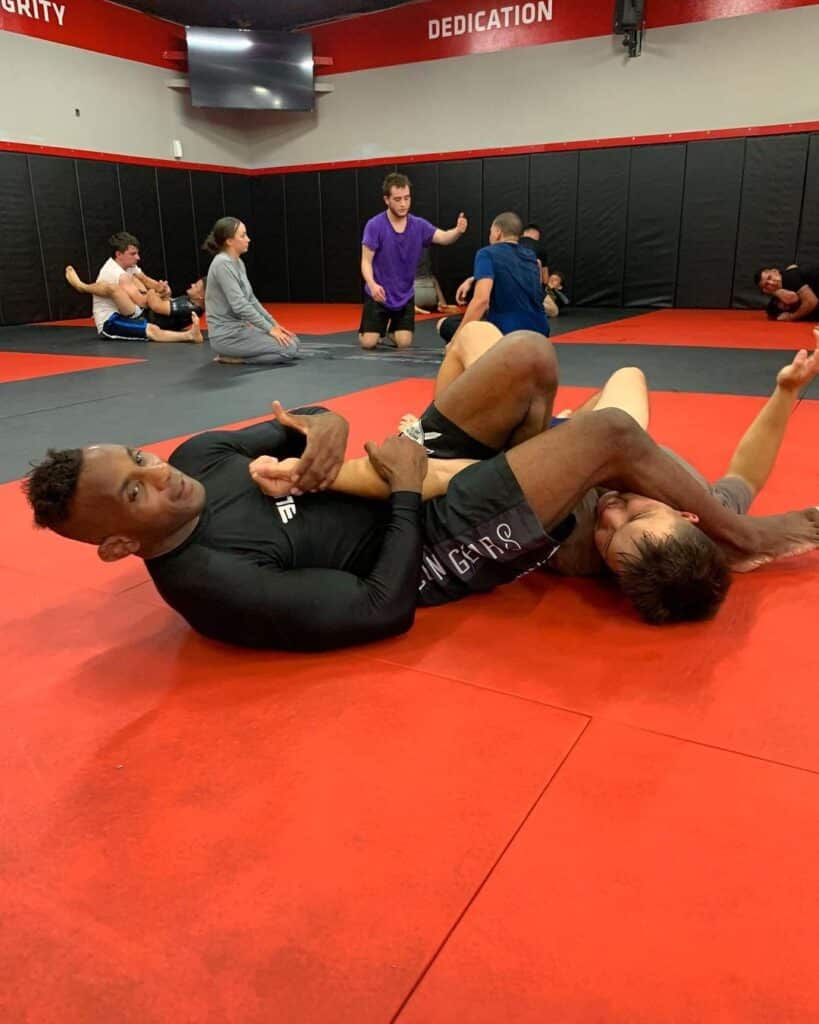Armbar – BJJ Submission Explained

An armbar is one of the most basic submissions you must know how to do. It’s one of the 5 basic submissions you learn in your first few classes at jiu jitsu school.
Although you do learn an armbar early in your Jiu Jitsu journey it takes years to perfect. There are always new armbar techniques to learn and tweaks to make your technique better.
Even if you’re a seasoned grappler, you can always do something to make your armbar better. This article is everything your need to know about the armbar. We’re going to tell you when they were invented, how they work, and a handful of the numerous techniques.

When was the armbar created?
The armbar is another one of these submissions that was created thousands of years ago. No one knows exactly who or when it was created, because every ancient culture that grappled did an armbar.
For as long as humans have tried to hurt each other, they study the physics of the human body. They figured it out pretty early if you bend an arm at an angle with enough pressure that they will break it.
Every modern form of grappling practices armbars from BJJ, submission wrestling, and Judo. The name for an arm-lock in Judo is juji-gatame. It is a submission that never stops being revolutionized.
How does an armbar work?
An armbar works in the same way you would pull a lever. When you go through the steps of controlling the opponent’s arm it looks exactly like a lever.
As you bridge your hips up it puts pressure on the opponent’s elbow joint. If you did all of the steps correct, then they should submit pretty quick.
Armbar from guard
A basic armbar from guard is tight and always a great go to move. But there are specific steps that have to be exactly in order for the armbar to work.
Pick the arm you want to attack and cross grab it at the tricep. With your other hand cross grab their shoulder to hold them in place and stop them from posturing up.
Your foot goes on the opponent’s hip and connects to their side next to the arm you’re attacking. After this step, you use your other leg to hook across their back. The reason for this is to break their posture further and hold them in place for the armbar.
Now that you’ve established control, you can do the last steps to get your armbar. Use your legs and hips to turn and get an angle for the submission.
For the last step pass your leg over their head, keep your knees tight, and bridge your hips up. Be sure to keep your leg heavy on their neck to keep them in place while you crank their arm.
Speed armbar from guard
If you have good hip mobility this is a good technique for you. It isn’t as tight as a traditional armbar set up, but it’s the fastest option.
All you do is control the opponent’s arm with your arm that’s on the same side. After this all you have to do is hook under their leg with your free hand.
This underhook allows your hips to turn and kick your leg over their head. When you get in position be sure to attack their arm with two hands behind you out the pressure on.
Armbar from mount
Here are the details for a basic armbar from mount. If your opponent sticks his arms out to defend this makes it easy for you to choose an arm.
Have your arms over and over the one you want to attack and grab at their tricep. Use this grip to pull their shoulder off the mat.
Next rotate your hips/legs around your opponent’s arm and step over their head. Be sure to keep your hips low when you do this.
After step over, establish control of their arm by squeezing your legs around it and hugging it to your chest. For the finishing step fall back slowly until your back touches the mat and bridge your hips for the tap.
Knee on belly armbar
When you have your opponent in knee on belly and they commonly defend by trying to push your knee. This opens them up to be put in an armbar when they do this.
Hook under their arm grabbing at the tricep and pull the opponent’s shoulder off the mat. Next lift your hips up and rotate around the opponent’s head.
The next step is similar to the finishing sequence of a mounted armbar. Hug their arm to your chest, pinch your knees around their arm, and fall back for the submission.
Reverse armbar from guard
A reverse armbar is an armlock, where you attack the opponent’s arm from an opposite angle. Using your arm to put downward pressure on their elbow joint.
Start by underhooking the arm that you want to attack. Then hip escape your hips out and attach your top leg to the opponent’s shoulder. Your inside leg attaches under their elbow locking them in place.
For the finish grip your hands together, put the blade of your wrist above their elbow to put pressure down.
Armbar from spider guard
There’s a tight armbar from the spider guard that is really easy to pull off. But first you have to get to the normal spider guard position.
Get sleeve grips on your opponent and put both of your feet. Straight the leg on the arm that you attack and turn your hips.
Then kick off your foot as you pull their arm into you. There’s already tension on their arm, so just bring your leg back over to get your armbar.
Armbar counter to lasso guard
When your opponent has you in lasso guard, there is a possible armbar counter available. The opportunity opens up if they have their outside leg too close to your body.
Grab a pant grip on their outside leg and pass it over to your arm they have in a lasso. Then immediately grab the sleeve of their free arm.
From there all you have to do is turn your opponent like a wheel. Turn them until their arm is between their leg, grab it with two arms, and take your armbar.
Tips
When you do armbars everything has to be in line in order for it to work properly. If one detail is off, then you’re not going to get the armbar. Remember all of these tips for you to be more successful.
- Turn And Angle: When doing an armbar from guard, you have to turn your body and make an angle. The reason you turn your body is because it makes it easier to get your leg over the opponent’s head. Once you clear the head and angle it allows you to be able to apply pressure on the arm.
- Break Their Posture: To get your opponent in place for an armbar, you have to break their posture. You do this by doing two movements. First grabbing their shoulder to keep them in position, then hooking your leg behind tier back.
- Arm Control: Make sure that you’re controlling the opponent’s above their elbow before attempting an armbar. Need to to establish good control to be able to attack their elbow joint.
- Heavy Leg: You need to make sure that you make your leg over the opponent’s head heavy. If you don’t do this, they can easily posture up and defend. This tip goes for armbars from top and bottom positions.
- Pinch Your Knees Together: Whenever you try for an armbar, you must pinch your knees together. Doing this keeps them in place and enables you to put pressure on the arm.
- Always Use Two Arms: Always use two arms against one when going for an armbar.
- Hug The Arm: On top of using two arms, you must hug the arm to your body. This allows you to use your whole body when you’re attacking an armbar.
- Thumb Up: Your opponent’s thumb must always be pointing up or aligned with your hips. This enables you to be able to apply pressure to the arm.
- Bridge Your Hips: Anytime you go to apply pressure on an armbar, you have to bridge your hips up. This motion puts the pressure on the arm.
- Stay Low: When you go for armbars from top positions be sure to keep your hips low. If your hips are high this either gives them space to escape and won’t be tight.






